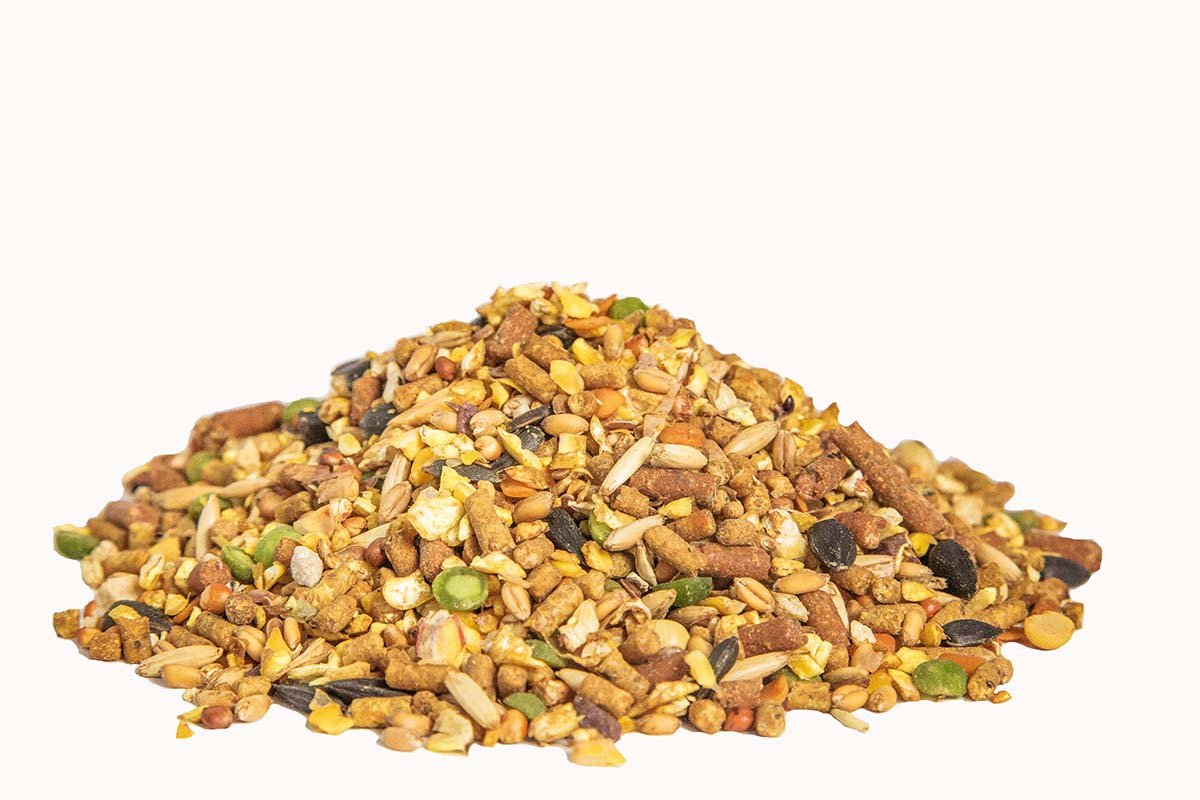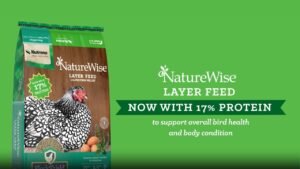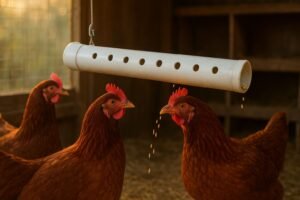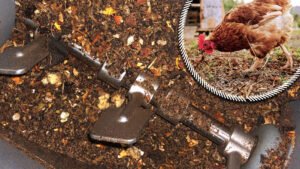When I first started raising chickens, I thought all feed was pretty much the same. That changed last March, right when egg prices skyrocketed and my flock’s egg production took a nosedive, and the yolks looked pale and sad.
It sent me down a rabbit hole of research, and that’s when I discovered Kalmbach Henhouse Reserve chicken feed. I’ll admit, I was skeptical at first, but this stuff actually delivered.
Now it’s my go-to feed. If you’re wondering whether this premium feed from Kalmbach Feeds is worth the investment, you’ve come to the right place.
This complete guide for late 2025 covers everything you need to know—from its unique ingredients and proprietary blends like LifeGuard® and YolkProud™ to a detailed price breakdown ($32-$37) and where to find it. Let’s dig in and see if this is the feed your flock has been waiting for.
Is Henhouse Reserve a Complete Feed? Understanding the Formula
This is the most critical question for any chicken keeper, and the answer is a definitive yes.
Kalmbach Henhouse Reserve Chicken Feed is formulated as a complete feed, which means it is designed to provide everything your laying hens need to thrive, starting from 16 weeks of age.
You do not need to add any extra supplements to their diet when using this Kalmbach Feeds product.
How Henhouse Reserve Prevents Common Nutritional Issues
Henhouse Reserve is engineered for results, not just sustenance.
This premium feed actively prevents common health problems and addresses nutritional deficiencies before they start.
Here is a more prominent look at its guaranteed analysis:
- Protein: A guaranteed 17% protein content, with a minimum of 0.85% lysine, meets the optimal requirements for consistent egg production and ensures hens can get through a molt efficiently.
- Calcium: A robust 3.5% to 4.5% calcium level, directly combating soft-shelled eggs and preventing “cage layer fatigue.”
- Fat: The minimum 4% fat content provides a high-quality energy source.
- Vitamins: A precise blend of vitamins, such as Vitamin A (min. 5,000 IU/lb) for mucosal integrity and Vitamin D3 (min. 2,000 IU/lb) for calcium absorption.
- Minerals: Essential minerals like manganese and zinc (min. 125 ppm) are included for strong leg bones and overall hen health, while phosphorus (min. 0.45%) supports their metabolic functions.
By providing a precise balance of nutrients, this feed helps your flock maintain optimal health from the inside out.
Now that we’ve confirmed its status as a complete nutritional powerhouse, let’s unpack the specific Kalmbach chicken feed ingredients that deliver these results.
Kalmbach Chicken Feed Ingredients: What’s Inside Henhouse Reserve
Henhouse Reserve is a vibrant, textured mix of whole grains and vegetables. The feed has a fresh, earthy, and slightly sweet smell from the molasses that my flock goes absolutely nuts for.
This sensory appeal comes from its high-quality, all-natural ingredient list. Due to the nature of natural ingredients, you may notice slight variations in the feed’s texture and pellet size between different batches.
Here’s a breakdown of what makes up this premium formula:
- Whole Grains: This forms the base of the feed, providing essential carbohydrates for energy. You can visibly see ingredients like Whole Corn, Oats, Whole Wheat, and Barley. This texture encourages natural foraging behavior. Note that while the feed’s visual appearance is similar to “scratch,” it is a complete and balanced layer feed, not a supplement. This is a common point of confusion for new users.
- Plant-Based Proteins: To reach that 17% protein layer feed benchmark, Kalmbach includes a variety of protein sources like Organic Peas, Lentils, and Sunflower Meal & Whole Sunflower Seeds.
- Nutritional Power-ups: These are the extras that elevate the feed.
- Dried Mealworms: A fantastic source of animal protein that chickens instinctively love.
- Oyster Shells & Calcium Carbonate: These provide both fast- and slow-release calcium for strong eggshells throughout the day and night.
- Cane Molasses: Added for palatability and to bind the ingredients, ensuring even picky eaters are drawn to the feed.
The LifeGuard® Proprietary Blend: A Deeper Dive
The true innovation in this Kalmbach chicken feed is the LifeGuard® proprietary blend, a multifaceted approach to digestive health support.
This isn’t just a single additive; it’s a synergistic mix designed to create a robust gut environment.
- Prebiotics and Probiotics for chickens: It contains beneficial bacteria (probiotics) and the food they need to flourish (prebiotics). This helps establish a healthy gut flora, making it harder for pathogens like Salmonella and E. coli to take hold.
- Essential Oils: The blend includes natural extracts from oregano, thyme, and rosemary. These oils are known for their natural antioxidant and antimicrobial properties, contributing to overall immune function in poultry.
- Enzymes: Specific enzymes are included to help break down complex carbohydrates in the grains, allowing your flock to extract more nutrients from every single bite.
YolkProud™ for Vibrant Egg Yolks
If you’re seeking those deep, rich, orange yolks, the YolkProud™ technology is the key.
This is a specific blend of all-natural carotenoids, primarily derived from marigold extract. These natural pigments are safely absorbed by the hen and deposited into the yolk, resulting in consistently vibrant egg yolks.
The color isn’t just cosmetic; it’s an indicator of a rich, well-rounded diet.
The thoughtful combination of these visible, high-quality ingredients with advanced nutritional technology is what sets Henhouse Reserve apart. Next, let’s address a practical concern for every chicken owner: the cost.
Henhouse Reserve Chicken Feed Price Guide
Prices as of September 2025
Henhouse Reserve is a premium feed that typically costs between $32.99 and $36.95. However, many flock owners find it’s worth every penny.
- Package Sizes: It is commonly available in 30 lb and 50 lb bags.
- Example Pricing:
- A 50 lb bag may be priced around $32.99 at certain retailers.
- A 30 lb bag may be priced at $36.95 at various farm and feed supply stores.
Is the Higher Price Justified? A Value Breakdown
The higher price of Henhouse Reserve Chicken Feed is justified by the hidden savings and improved performance.
Because it is a complete feed, you may no longer need to buy supplemental oyster shells or vitamin boosters. The enhanced digestive support from LifeGuard® can lead to a healthier flock with fewer health issues.
Furthermore, the high-quality ingredients mean a superior feed conversion ratio. This translates to your chickens producing more eggs per pound of feed, with some users reporting a 15-20% improvement in egg production consistency.
However, it’s crucial to understand that results can vary widely depending on the flock’s health, age, and environment. While some chicken keepers report significant gains, others may not see the same dramatic improvement, making the cost-benefit less pronounced.
For example, one user reported that after switching their three-year-old hens from a standard feed like Purina, the flock “started laying up a storm” and achieved “100% egg hatch daily.”
Let’s do a quick cost-per-egg comparison:
| Metric | Standard Feed (e.g., $25/50lb bag) | Kalmbach Henhouse Reserve ($33/50lb bag) |
|---|---|---|
| Daily Consumption | approx. 5 oz/hen | approx. 5 oz/hen |
| Production Rate | approx. 1 egg per day per hen | 1.15 eggs per day per hen (15% increase) |
| Cost Per Dozen | $1.92 | $1.83 |
As this calculation shows, even with a higher bag price, the improved production rate can lead to a lower cost per dozen eggs.
Tips for Finding the Best Price
To potentially save money, opting for the largest bag size available may offer a lower price per pound.
It may also be beneficial to check for seasonal sales at local feed stores.
Signing up for a retailer’s loyalty program or email list could provide access to coupons. For online ordering, some websites may offer subscription deals that can lower the per-bag cost.
With a clear understanding of the cost, let’s explore how to find this exceptional feed for your flock.
Finding Henhouse Reserve Chicken Feed Near Me
You can find Henhouse Reserve at major farm supply retailers and online. While it’s a national brand, it’s particularly prevalent in agricultural regions. Your best bet is to check with local farm supply and feed stores. A quick search for “Henhouse reserve chicken feed near me” will yield the most current results, but common retailers include:
- Tractor Supply
- Chewy.com (for online ordering and delivery)
- Farm and Home Supply
- Agway CT
- Russell Feed & Supply
- Specific Retailer Availability (as of September 2025):
- Chewy: The feed is available on Chewy.com, with both 30-lb and 50-lb bags listed as in stock. They offer free shipping on qualifying orders.
- Family Farm and Home: The website for Family Farm and Home shows the 30-lb bag of Henhouse Reserve is currently in stock.
- Ludwig’s Feed Store: This retailer lists the 30-lb bag of Kalmbach Henhouse Reserve on its website, indicating its availability.
To find a store near you, a good method is to visit the official Kalmbach Feeds website and use their store locator. It is recommended to call the store ahead to ensure they have the 30 lb or 50 lb bags in stock before you make a trip.
Now that you know where to get it, it’s crucial to know how to properly feed it to your flock for the best results.
Can Chickens Eat Henhouse Reserve? Feeding Instructions and Guidelines
This feed is designed for the optimal health of laying hens. For the best results, follow these clear guidelines:
- When to Start: Begin feeding Henhouse Reserve to your hens starting at 16 weeks of age.
- Feeding Method: This feed should be provided as the sole ration on a free-choice basis.
- Daily Consumption: A standard laying hen will typically consume about 5 ounces (or roughly 1/4 pound) of feed per day.
- Fresh Water: Always provide constant access to fresh, clean water.
How to Properly Transition Your Flock to Henhouse Reserve
Chickens can be wary of change, so switching feed abruptly can cause them to go off their food. A gradual transition over 7-10 days is best:
- Days 1-3: Mix 75% old feed with 25% Henhouse Reserve.
- Days 4-6: Mix 50% old feed with 50% Henhouse Reserve.
- Days 7-9: Mix 25% old feed with 75% Henhouse Reserve.
- Day 10: Feed 100% Henhouse Reserve.
Common Feeding Mistakes and Troubleshooting
I’ll be honest, the first week was rough – my girls sorted through everything looking for the mealworms. The textured nature of this feed can cause common issues, such as selective eating and a perceived dryness.
Based on numerous customer reviews, a very common issue is that chickens “pick and choose what they want to eat,” leaving some of the less-preferred ingredients behind.
One user even noted that they “had to resort to wetting the feed to get them to eat it.” This is a key concern for many buyers, and here are some solutions to address it:
- Addressing Selective Eating: To prevent your flock from sorting through the feed and wasting ingredients, consider using a feeder that discourages this behavior, such as a treadle feeder or one with smaller ports. As another solution, spreading the feed in a wide, shallow container can encourage your flock to eat everything, as it prevents them from easily “billing out” or flipping food out of the bowl.
- Fixing a Dry Consistency (Wetting the Feed): As some users have discovered, lightly moistening the feed with a small amount of warm water can dramatically improve its palatability and reduce waste. Another popular method is to add a splash of apple cider vinegar (ACV) to their drinking water, which can also aid in gut health.
- Troubleshooting Feed Waste: To reduce waste, consider using a specialized feeder that prevents chickens from kicking the feed out of the bowl. Place the feeder in a sheltered area to prevent rain from spoiling the feed.
If you are using the organic version of this feed, some users report their chickens avoiding the nutrient-rich green pellets. This is a normal behavior as they get used to the new texture. The gradual transition method outlined above is the best way to acclimate them.
Alternative Feeding Strategies for Budget-Conscious Keepers
Budget-conscious chicken keepers often use alternative feeding strategies, such as mixing Henhouse Reserve with other feeds.
This can be especially useful for those on a budget, or for providing specific boosts during different seasons. For example, one reviewer stated, “I mix it with cracked corn in the winter and with their crumbles.”
- Mixing with Cracked Corn: During cold winter months, mixing Henhouse Reserve with a small amount of cracked corn can provide your flock with extra carbohydrates and fat, which helps them generate body heat. This is a common practice but remember that cracked corn offers little protein, so be careful not to dilute the feed’s nutritional value too much.
- Mixing with Standard Crumbles/Pellets: For keepers looking to reduce cost, mixing Henhouse Reserve with a less expensive standard crumble or pellet feed can be an effective strategy. This allows your flock to still benefit from the premium ingredients and proprietary blends of Henhouse Reserve while keeping the overall cost per bag lower.
While mixing can be a useful strategy, it’s important to remember that it can dilute the balanced nutrition of the complete feed. Always ensure your flock is still receiving the necessary vitamins and minerals for optimal health.
Proper feeding is key to unlocking the full potential of this feed, which truly stands in a class of its own.
Kalmbach Feeds: Why Henhouse Reserve Stands Out Among Chicken Feed Brands
When it comes to the chicken feed aisle, Kalmbach Henhouse Reserve has carved out a distinct identity.
The primary differences between it and regular layer feed are the visible whole-grain ingredients and the inclusion of the proprietary LifeGuard® (for gut health) and YolkProud™ (for yolk color) technologies.
It’s a brand built on the authority of Kalmbach Feeds, a family-owned company known for quality and animal nutrition.
| Feature | Kalmbach Henhouse Reserve | Regular Layer Feed |
|---|---|---|
| Protein Content | 17% | 16-18% |
| Whole Grains Visible | Yes, textured blend | Usually No, uniform pellet/crumble |
| LifeGuard® Technology | Yes (Probiotics, Enzymes) | No |
| YolkProud™ | Yes (For vibrant yolks) | No |
| Price (50 lbs) | $32.99 | $25-30 |
| Complete Feed | Yes | Yes |
Organic vs. Conventional Henhouse Reserve
For the discerning flock owner, Kalmbach also offers USDA Certified Organic Henhouse Reserve.
This version is not only organic but is also formulated to be soy-free and corn-free, making it one of the premier organic chicken feed options available. Note that the conventional Henhouse Reserve contains soybean meal.
The organic version provides all the benefits of the conventional formula while adhering to the strictest organic standards. The organic version contains 16% protein, an important distinction from the conventional feed’s 17% protein content.
While Henhouse Reserve is optimized for layers, many people wonder about its effect on growth. Let’s clarify that common question.
Which Feed Makes Chickens Grow Faster? Henhouse Reserve Performance Analysis
This is a common question, but it’s important to clarify the purpose of this feed.
Henhouse Reserve is a layer feed, not a grower feed. Its formula is optimized to support the long-term health and peak productivity of laying hens, not the rapid muscle growth required for meat birds.
A flock on this feed will not “grow faster,” but you can expect to see performance improvements in other key areas: consistent egg production, superior egg quality, and improved flock vitality.
For raising chicks, you would use a starter/grower feed and then transition to Henhouse Reserve at 16 weeks.
Can Henhouse Reserve improve egg production in older hens? While it can’t reverse the natural decline in laying that comes with age, providing older hens with high-quality, easily digestible nutrition can support their bodies and help them continue laying consistently for longer.
It’s also worth noting a common point of discussion among experienced keepers. While Henhouse Reserve is a top-tier layer feed, some poultry enthusiasts who manage mixed-age flocks with younger pullets and older hens may find a different Kalmbach product to be more suitable. One reviewer noted that “a better option IMO is kalmbach’s flock maker pellets” because it’s designed to be a single feed for a flock of all ages, from chicks to layers.
Can Henhouse Reserve Be Fed to Other Poultry?
A frequent question among keepers with mixed flocks is whether this feed is suitable for other poultry like ducks, quail, or geese.
While it is primarily formulated for chickens, it can be used in a pinch or for a short period, but it’s not the ideal long-term solution. Each type of poultry has different nutritional requirements, and a dedicated feed is always best.
- Ducks and Geese: Henhouse Reserve has a high calcium content, which is essential for laying hens but can be harmful to ducks and geese in excess. Ducklings in particular need a feed with lower niacin content. If feeding to ducks, you must provide a separate source of grit and free-choice oyster shell if they are laying.
- Quail: Quail need a much higher protein content than chickens. While Henhouse Reserve’s 17% protein is good for chickens, it’s typically too low for optimal egg production in quail, which often require 20% protein or more.
If you have a mixed flock, it’s generally recommended to provide separate feeders with a feed formulated for each species to ensure they get the right nutrition.
Henhouse Reserve Block vs Regular Feed: Format Options Explained
You may also come across the Henhouse Reserve block, which is an important product to understand. Unlike the bagged feed, the block is a supplemental treat and not a complete feed replacement. It is specifically designed to provide enrichment and combat boredom.
When and Why to Use the Henhouse Reserve Block
The block is an excellent tool for coop management.
Place one in the run during the winter when foraging is impossible, or during times of stress, like when introducing new birds.
The pecking action required to get the grains provides mental stimulation and can help prevent negative behaviors like feather picking.
Think of the Kalmbach Feeds’ Henhouse Reserve block as a healthy, long-lasting activity, while the bagged feed is the essential daily meal.
Understanding the different product formats helps you choose the right nutrition, which brings us to the ultimate question.
What Is the Best Feed Brand for Chickens? Comparing Top Options
What’s the best feed brand for chickens? Honestly, it depends on what you’re trying to do.
For the chicken keeper who prioritizes all-natural ingredients, superior egg yolk color, and proactive digestive health support, Kalmbach Henhouse Reserve is arguably one of the best options on the market.
If your primary concern is budget, a standard pellet from a brand like Nutrena or Manna Pro may meet basic needs.
If you are a purist seeking strictly organic, soy-free options, a brand like Scratch and Peck is an excellent choice. However, for a unique balance of visible, whole-food ingredients and advanced nutritional technology that delivers noticeable results in your egg basket, Henhouse Reserve provides a compelling and unique value.
Seasonal and Storage Recommendations
Proper storage and feeding adjustments can extend the life of your feed and keep your flock healthy year-round.
After the particularly harsh cold snap last winter, many of us had to re-evaluate our winter feed plans, which is a great time to start.
- Storage: Store the feed in a cool, dry place and use it within 6 months of the manufacturing date for optimal freshness and nutrient content. During the 2024 feed shortage, many people started using sealed, metal or plastic bins to keep their supply secure from pests and moisture.
- Seasonal Feeding: In winter, a chicken’s energy needs increase. Consider providing warm water to encourage them to stay hydrated and a small, high-protein treat (like dried mealworms) in the afternoon to fuel them overnight. In summer, ensure they have ample shade and cool, fresh water to prevent heat stress.
Frequently Asked Questions on Henhouse Reserve Chicken Feed
Is Kalmbach Henhouse Reserve a complete feed?
Yes, Henhouse Reserve is a complete layer feed, meaning it provides all the necessary nutrients for laying hens and requires no additional supplements.
Does Henhouse Reserve contain soy?
The conventional version of Henhouse Reserve contains soybean meal. If you are looking for a soy-free option, the organic version is formulated without corn or soy.
What is the difference between the Henhouse Reserve feed and the block?
The bagged feed is a complete, daily ration for your flock, whereas the Henhouse Reserve block is a supplemental treat designed for enrichment and to combat boredom.
What are the benefits of the LifeGuard® and YolkProud™ blends?
LifeGuard® is a proprietary blend of prebiotics and probiotics that supports gut health and a robust immune system. YolkProud™ uses natural marigold extract to enhance the vibrancy and color of your hens’ egg yolks.
Conclusion: The Verdict on Henhouse Reserve Chicken Feed
After months of feeding Kalmbach Henhouse Reserve chicken feed to my own flock, I can confidently say it lives up to the hype.
It is a premium, complete feed that delivers visible results in egg quality, flock health, and overall vitality.
While the price point is higher, the combination of whole-food ingredients, zero need for supplements, and advanced health blends provides exceptional value.
If you’re looking to elevate your flock’s nutrition and enjoy the best eggs possible, making the switch to Henhouse Reserve Chicken Feed is a decision you and your chickens will be happy with.
The next step is to use the store locator guides to find a bag near you and see the difference for yourself.

Oladepo Babatunde is the founder of ChickenStarter.com. He is a backyard chicken keeper and educator who specializes in helping beginners raise healthy flocks, particularly in warm climates. His expertise comes from years of hands-on experience building coops, treating common chicken ailments, and solving flock management issues. His own happy hens are a testament to his methods, laying 25-30 eggs weekly.



